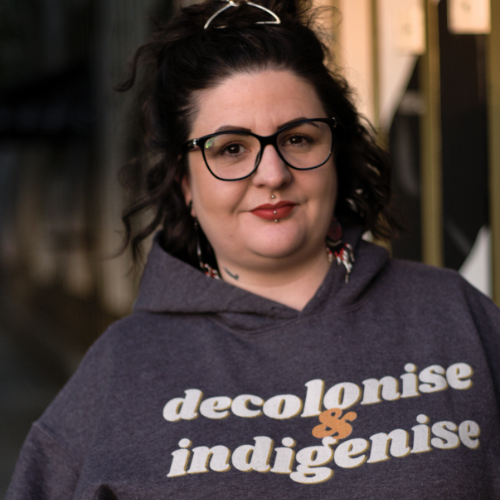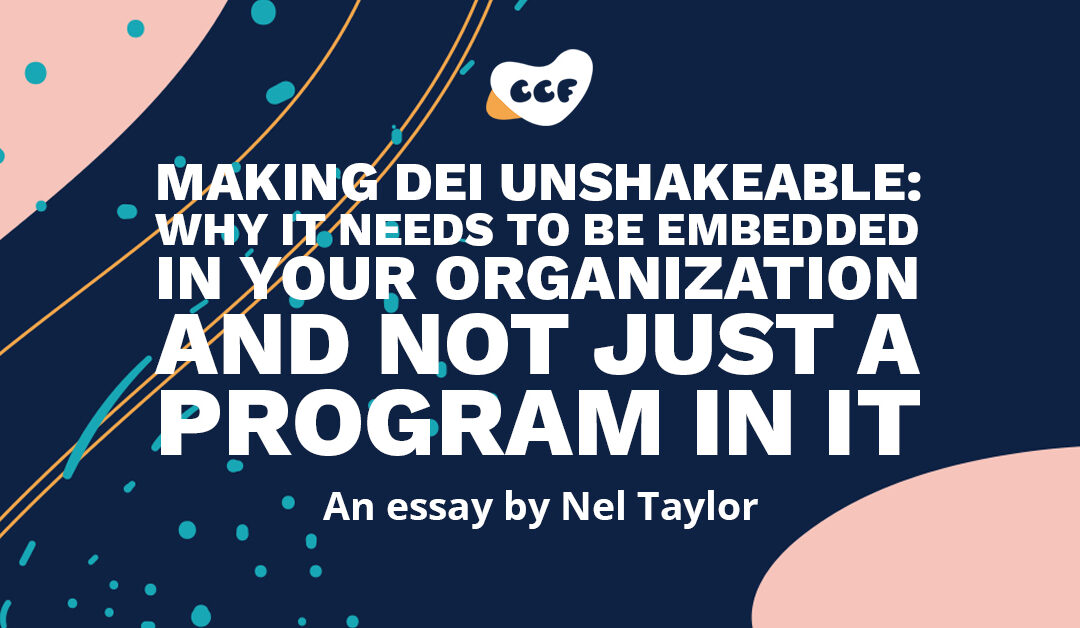By Nel Taylor, (Umatilla) they/them, he/him — queer, trans, fat, organizational change and anti-racist DEIJ consultant
This is a time to move beyond only diversity-based initiatives… and make the structural changes necessary to create a workplace where Black, Indigenous, People of Color, disabled, queer, trans and gender-expansive people, and others who face systemic oppression are safe to work.
DEI isn’t dead—but it’s under attack, and it’s time to change how we do it.
Diversity, equity, and inclusion (DEI) has never just been about workshops, awareness months, or committees—it’s about transforming the actual structures of our workplaces. Equity lives in pay scales, hiring practices, accountability systems, and the policies we often take for granted. When DEI is baked into these policies—not just tacked on as a program—it’s harder to defund, harder to politicize, and actually improves the workplace for everyone.
The recent wave of anti-DEI rhetoric makes it even more urgent to get this right. We don’t need less structure—we need better structure.
In his first week in office, Donald Trump issued several executive orders. I considered listing a few, but I don’t want to put you through that again. Among the horrifying wave of assaults on human rights, Trump put out a hit on DEI. Along with the executive order ending all federal DEI and environmental justice (yes, that’s called out by name) programming, pulling federal funding for DEI programs in the third sector, and compiling a list of all DEI-related positions, committees, services, activities, expenditures, and every contractor who provided the federal government with DEI training and materials, the white house (they don’t deserve capitalization) also launched a public smear campaign on “DEI”—which, to them, seems to mean anyone who has a job who is not a white cis man.
The white house is doing what I think many people do—even those committed to DEI work—they are hyperfocused on Diversity without fully understanding the “E” and “I.” Many people think they’re talking about Equity when they really mean Diversity.
Obviously, there’s a difference in the harm caused when the federal government defines and targets people solely on their identity characteristics, and when a well-meaning nonprofit thinks that DEI work ends at racial sensitivity trainings—don’t mistake me for conflating the two. But it does warrant a revisit of these definitions.
Diversity
Diversity is all the ways that people are different at individual and group levels. Organizational diversity requires examining and questioning the makeup of a group to ensure that multiple perspectives are represented.
Equity
The process of redistributing material and non-material access and opportunity, often at the expense of equality, to be fair and just; the state of being free of bias, discrimination, and identity-predictable outcomes (i.e., knowing that a Black woman is more likely to be denied medical treatment than her white counterparts).
Trump’s dangerous rhetoric about diversity puts a blanket condemnation on DEI, which impacts so much more than diversity and definitively benefits everyone, regardless of race, gender identity, sexuality, or disability.
With DEI under attack, many nonprofits are taking their equity statements off their websites and rolling back their DEI initiatives, but we don’t have to respond out of fear.
This is a time to move beyond only diversity-based initiatives, such as awareness training and cultural celebrations, and make the structural changes necessary to create a workplace where Black, Indigenous, People of Color, disabled, queer, trans and gender-expansive people, and others who face systemic oppression are safe to work. Without transforming policies and practices, we risk inviting people into environments where they must mask, code-switch, and assimilate just to survive—while also being targeted as “DEI hires.”
We can take the philosophies of Diversity, Equity, Inclusion, and Justice beyond DEI committees and operationalize them through systemic changes—changes such as equitable pay, non-punitive accountability, redistribution of decision-making power, and equitable hiring practices. These systems live in our HR policies and employee handbooks.
Equity isn’t a program, a committee, or a line item on a budget—it’s the water you swim in. And when we embed it into our policies, our decision-making, and our day-to-day operations, it’s much harder to defund, dismiss, or destroy.
When DEI is policy, it is not a “program.” When the philosophies of equity are deeply embedded into all parts of the organization, it’s no longer a separate entity that can be targeted and defunded.
Author of DEI Deconstructed:Your no-nonsense guide to doing the work and doing it right and Reconstructing DEI: A practitioner’s workbook, Lily Zheng, recently published an article in the Harvard Business Review debuting their new approach to equity work, the Fairness, Access, Inclusion, and Representation (FAIR) framework. The FAIR framework applies “a change management approach to create impact at scale, improving personnel policies; hiring, promotion, and feedback processes; leadership incentives; and organizational culture and norms, rather than repeatedly seeking to ‘build awareness’ without follow-up.”
Too often, organizations postpone these structural changes until a crisis forces their hand.
Maybe it’s a discrimination complaint, a wrongful termination case, or a staff uprising—either way, the urgent scramble to patch things up usually leads to sloppy, reactive fixes. But when we make the changes that many hoped would be the outcome of DEI committees in the first place, we don’t just avoid crises. We dismantle white supremacist systems, foster inclusion and belonging, improve morale, retain a diverse workforce—and, yes, reduce the risk of getting sued (if you care about that sort of thing).
Some people hear policy and structure and immediately think of rigidity, control, or bureaucratic nonsense—and honestly, they’re not wrong. Many of the systems we’ve inherited were built exactly for that: to control, to punish, and to preserve inequity. But structure itself isn’t the problem. In fact, standardization, when done with care, is one of the most powerful tools we have for equity.
This is the difference between coercive bureaucracy and enabling bureaucracy. Coercive bureaucracy uses policy to gatekeep and protect power. Enabling bureaucracy uses policy to create consistency, predictability, and real access—especially for those historically pushed out or harmed by “unspoken rules.”
The goal isn’t to get rid of structure; it’s to build better structures.
Equity isn’t a program, a committee, or a line item on a budget—it’s the water you swim in. And when we embed it into our policies, our decision-making, and our day-to-day operations, it’s much harder to defund, dismiss, or destroy.

Nel Taylor
Nel Taylor (they/them and he/him) is an organizational development, Diversity, Equity, and Inclusion, Human Resources, and fundraising strategy consultant with over 13 years of nonprofit experience. As the Founder and Steward of Now This Consulting, Nel guides organizations through operationalizing anti-racist principles into everyday operations and practices, moving their clients beyond DEI committees, into direct action and organizational change.
Their introduction to nonprofit work came out of their transition from houselessness when they were 18 years old. After experiencing exploitation at the hands of the nonprofit industrial complex, they set out to shift the traditional practices and systems that perpetuate harm throughout the nonprofit sector.
Register for Nel’s free webinar on advancing Equity through today’s political challenges
Join the upcoming cohort of Rethinking HR–Transforming Policies for Workplace Equity and Justice. This 12-week live course begins May 1, 2025 Use code CCF for $250 off tuition.
Connect with him on Instagram @nowthisconsulting, LinkedIn, TikTok, or via their website nowthisconsulting.com. If you appreciated this article, consider sending some love via Venmo; it’s hard out here for a DEI consultant.
Discover more from CCF
Subscribe to get the latest posts sent to your email.


This article is so great. I think so many orgs think of DEIJ work as “bonus work” and operationalize it as such, when it needs to be imbedded in policy and practice throughout an organizational structure. Thanks for writing this!
Thank you so much! I’m glad this landed with you!
Great article, Nel. We need to take the work of justice and equity deeper, not be bullied back into oppression by a tyrannical government.
Yes! Thank you so much!